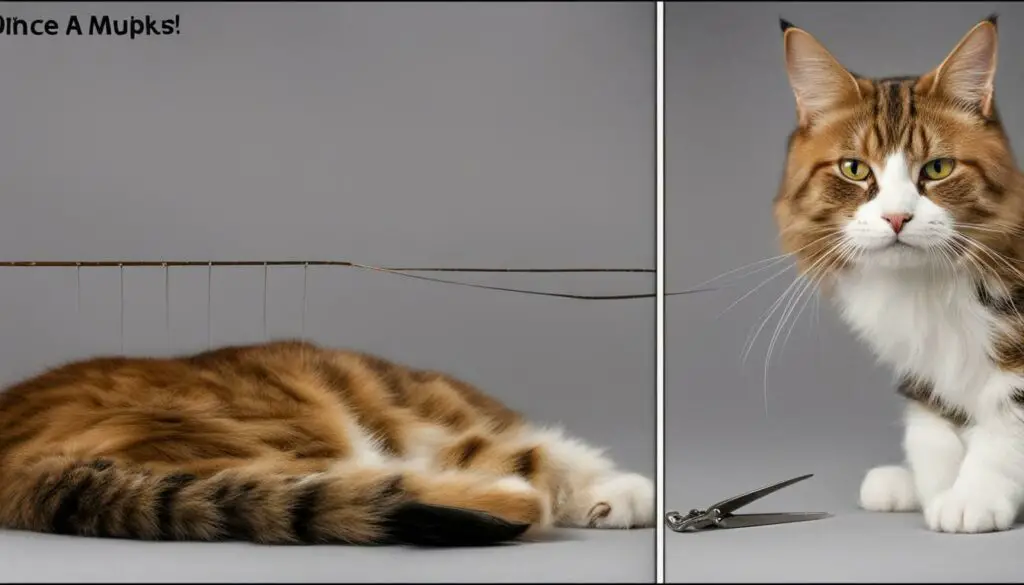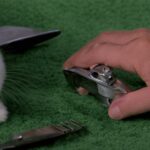Welcome to my practical guide on how often to clip your cat’s nails to keep their paws healthy and safe. Regular nail trimming is an essential part of cat care, ensuring their overall well-being and preventing any potential damage. By maintaining a consistent schedule for nail clipping, you can help your furry friend avoid discomfort and maintain healthy claws.
Key Takeaways:
- Trim your cat’s claws every two to three weeks to maintain a manageable length.
- Use appropriate tools like scissors, clippers, or guillotine-style clippers with sharp blades to avoid causing pain or bleeding.
- Create a positive association with the clippers by offering treats whenever they are present to make the process easier.
- Get your cat comfortable with having their paws touched by gently rubbing their paws and rewarding them with treats.
- When trimming, only remove the sharp tip of the nail and avoid cutting into the quick, where nerve endings and blood vessels are located.
Establishing a regular trimming schedule and seeking professional help if needed are important considerations. Approach the nail trimming process with patience and a calm demeanor to ensure a stress-free experience for both you and your cat. By following these guidelines, you can maintain your cat’s paw health and keep their claws in optimal condition.
Why Regular Cat Nail Care is Important
Regularly caring for your cat’s nails is crucial not only for maintaining their health but also for preserving your furniture and preventing accidental scratches. Cats’ nails can grow long and sharp, which can lead to discomfort or even injury for your furry friend. By trimming their nails regularly, you can prevent any issues and promote their overall well-being.
One of the primary reasons for regular cat nail care is to prevent damage to your furniture and belongings. Cats naturally scratch and sharpen their claws, and if their nails grow too long, they may inadvertently scratch your upholstery, carpets, or other valuable items in your home. By keeping their nails trimmed, you can minimize the risk of these accidents happening and protect your belongings.
Additionally, untrimmed nails can also lead to injuries. If a cat’s nails become too long, they may get caught on things, causing discomfort or even tearing the nail. This can be painful for your cat and may require veterinary attention. By regularly clipping their nails, you can prevent such injuries and ensure their paws remain healthy.
Quote:
Regular cat nail care is essential for maintaining your feline friend’s health, preventing damage to your furniture, and minimizing accidental injuries. By establishing a consistent nail trimming routine, you can provide a safe and comfortable environment for both your cat and yourself.
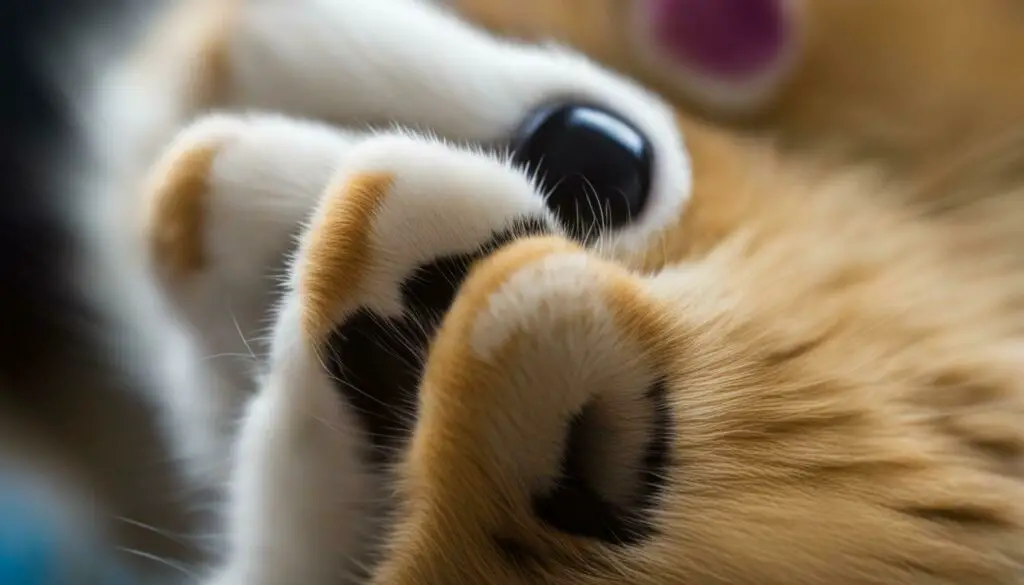
In conclusion, regularly caring for your cat’s nails is not only a matter of hygiene but also a crucial aspect of their overall well-being. By trimming their nails every two to three weeks, you can prevent damage to your furniture, reduce the risk of injuries, and maintain a harmonious relationship between you and your feline companion. Remember to approach the nail trimming process with patience and a calm demeanor, ensuring the comfort and safety of your cat throughout the procedure.
Recommended Frequency for Cat Nail Clipping
When it comes to trimming your cat’s nails, it is generally recommended to do so every two to three weeks for optimal nail length. Regular nail trimming is important for maintaining your cat’s health and preventing damage to furniture. Keeping their claws at a manageable length not only helps prevent scratches on your belongings but also ensures your cat’s comfort and well-being.
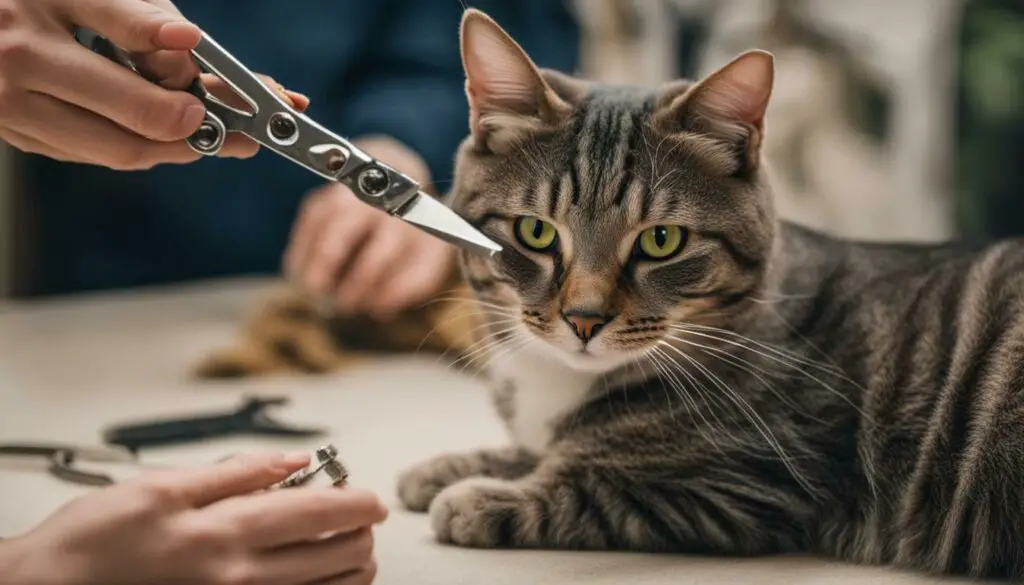
There are various tools available for cat nail grooming, such as scissors, clippers, or guillotine-style clippers. It is important to use sharp blades to ensure a clean cut and minimize discomfort for your cat. Dull blades can cause pain, bleeding, and even splintering of the nails. So, it’s worth investing in quality tools that will make the nail trimming process easier and more efficient.
To make the nail trimming experience more pleasant for your cat, you can create a positive association with the clippers. Offer treats whenever the clippers are present, so your cat starts associating them with positive experiences. Additionally, it’s helpful to get your cat comfortable with having their paws touched. Gently rubbing their paws and rewarding them with treats will help create a positive association with paw handling and make the nail trimming process smoother.
Table: Recommended Cat Nail Clipping Frequency
| Frequency | Recommendation |
|---|---|
| Every 2 weeks | For cats with fast-growing nails or indoor cats with limited scratching opportunities. |
| Every 3 weeks | For cats with average nail growth and regular scratching outlets. |
| Every 4 weeks | For cats with slower nail growth or outdoor cats with ample scratching opportunities. |
When trimming your cat’s nails, it’s important to only trim the sharp tip of the nail and avoid cutting into the quick. The quick is the pink part of the nail where nerve endings and blood vessels are located. Cutting into the quick can cause pain, bleeding, and potential infection. If you’re unsure about how to properly trim your cat’s nails, consulting a veterinarian or professional groomer can provide guidance and ensure your cat’s safety.
By establishing a regular trimming schedule, creating a positive association with nail clippers, and using the proper technique, you can successfully maintain your cat’s nail health and overall well-being. Remember to approach the nail trimming process with patience and a calm demeanor, as your cat’s comfort and trust are of utmost importance.
Tools for Cat Nail Clipping
To effectively clip your cat’s nails, you can choose from a variety of tools, including scissors, clippers, or guillotine-style clippers. Each tool has its own benefits and considerations, so it’s important to find the one that works best for you and your cat.
Scissors: Scissors are a common choice for cat nail trimming. They are easy to handle and provide good control over the clipping process. It’s important to use scissors with sharp blades to ensure a clean and precise cut, reducing the risk of pain or bleeding. Remember to trim only the sharp tip of the nail and avoid cutting into the quick.
Clippers: Clippers are another popular option for cat nail clipping. They come in different sizes and styles, so you can choose the one that suits your cat’s nails best. Similar to scissors, it’s important to use clippers with sharp blades for a clean and safe trim. Take care to trim only the sharp tip and avoid cutting into the quick.
Guillotine-style clippers: Guillotine-style clippers are specifically designed for cat nail trimming. They have a hole where you insert the nail, and a blade that slides across to cut it. These clippers provide good control and visibility, but they may require a bit more practice to use effectively. Again, ensure that the blades are sharp and that you trim only the tip of the nail.
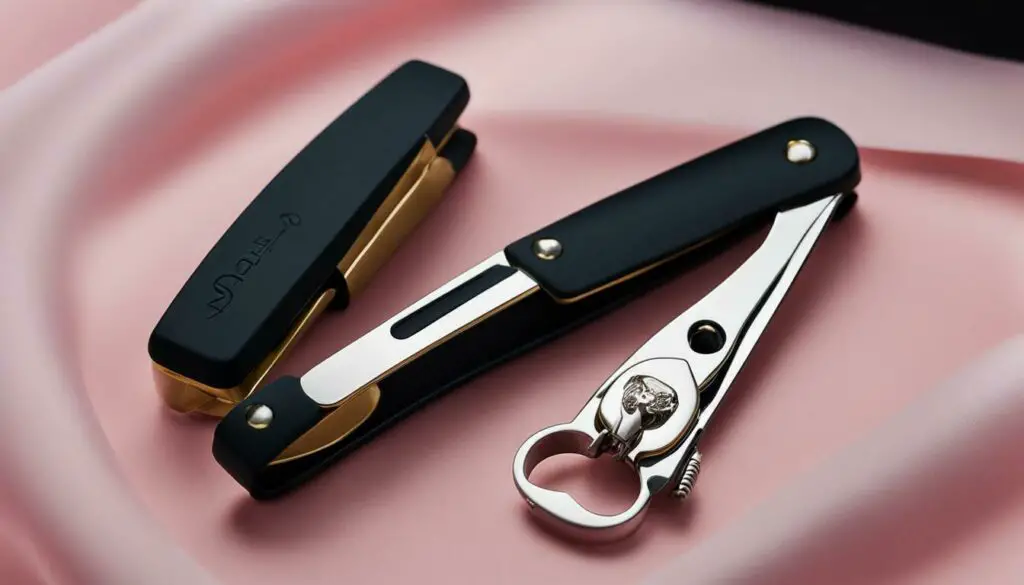
When using any of these tools, it’s important to approach the process with patience and a calm demeanor. Avoid rushing or reprimanding your cat, as this can cause stress and anxiety. Instead, make the experience more positive by offering treats and praise. By finding the right tool and following these guidelines, you can effectively clip your cat’s nails and keep them happy and healthy.
Creating a Positive Association with Nail Clippers
Making nail trimming a positive experience for your cat is essential, and one way to achieve this is by associating the clippers with treats and rewards. You can create a table to keep track of your cat’s progress and reward them accordingly. Use the
tag to create a table. For example:
| Trimming Session | Treats Given |
|---|---|
| First session | 2 treats |
| Second session | 3 treats |
| Third session | 4 treats |
This table can help you keep track of your cat’s progress and reward them with increasing treats as they become more comfortable with the nail clippers. Remember to use the em tag to emphasize important words within your text.
In addition to treats, it is also helpful to get your cat comfortable with having their paws touched. Gently rubbing their paws and rewarding them with treats can help create a positive association. You can use an unordered list to summarize these tips:
- Gently rub your cat’s paws to get them used to the sensation.
- Offer treats as a reward for allowing their paws to be touched.
- Gradually increase the duration of paw handling sessions.
- Always end the session on a positive note with treats and praise.
By following these tips and using positive reinforcement techniques, you can help your cat feel more comfortable and cooperative during nail trimming sessions. Remember to approach the process with patience and a calm demeanor. You can include a relevant quote to emphasize the importance of patience:
“Patience is the key to success when it comes to trimming your cat’s nails. Take your time and allow your cat to adjust to the process at their own pace.” – Dr. Jane Smith, Feline Behavior Specialist
Example of a Positive Association with Nail Clippers
One cat owner, Lisa, shared her success story of creating a positive association with nail clippers:
“At first, my cat, Whiskers, was terrified of the nail clippers. But by following the tips of offering treats and rewards, and gradually getting him comfortable with paw handling, we’ve turned nail trimming into a pleasant experience. Now, Whiskers willingly extends his paws for trimming, and I no longer dread this task. It just goes to show that patience and positive reinforcement can make a world of difference!” – Lisa, proud cat owner
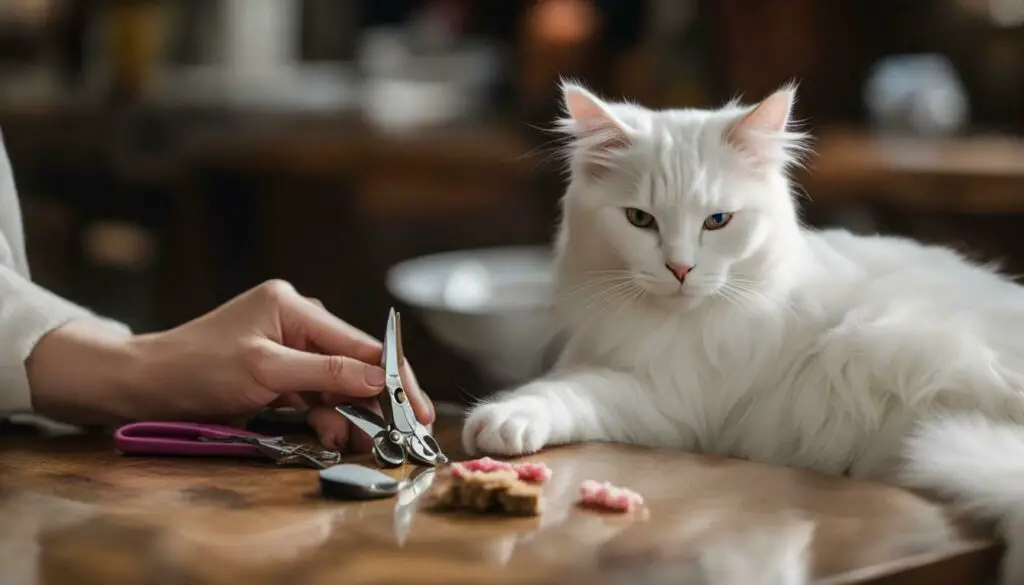
Remember, creating a positive association with nail clippers is a gradual process. It may take time for your cat to feel completely at ease, but with patience, consistency, and plenty of treats, you can make nail trimming a stress-free activity for both you and your feline companion.
Getting Your Cat Comfortable with Paw Handling
Before jumping into nail trimming, it’s important to get your cat comfortable with having their paws touched and handled. This will help reduce anxiety and make the process much easier for both you and your feline friend.
Start by creating positive associations with paw handling. Gently rub your cat’s paws during playtime or while giving them treats. This will help them associate paw touching with positive experiences. Be patient and take it slow, as it may take some time for your cat to feel comfortable.
Another technique you can try is desensitization. Gradually increase the amount of pressure you apply to your cat’s paws over time. Start with gentle touches and gradually work your way up to holding their paws for longer periods. Reward your cat with treats and praise during this process to reinforce positive behavior.
| Tip: | Try using a clicker or a verbal cue, such as “paw,” when rewarding your cat for allowing paw handling. This will help them associate the cue with a positive experience. |
|---|
Remember to always respect your cat’s boundaries and take breaks if they become stressed or agitated. Positive reinforcement and patience are key when it comes to getting your cat comfortable with paw handling. By taking the time to build trust and create a positive association, you’ll make the nail trimming process much easier and stress-free for both you and your furry companion.
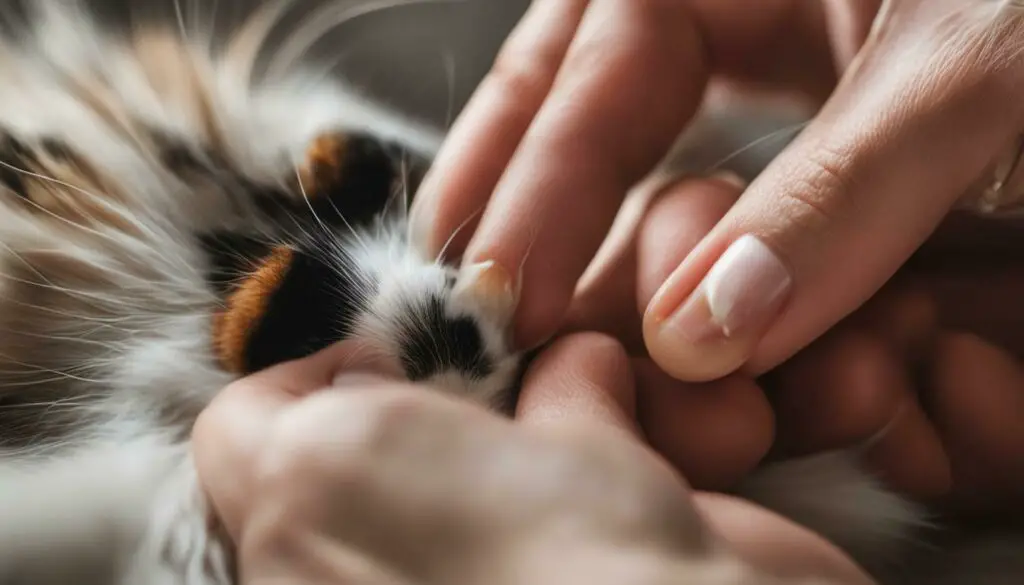
Summary:
Before jumping into nail trimming, it’s important to get your cat comfortable with having their paws touched and handled. You can do this by creating positive associations with paw handling through gentle rubbing and offering treats. Desensitization techniques, such as gradually increasing pressure on their paws, can also help. Remember to be patient and respect your cat’s boundaries. By establishing trust and positive associations, you’ll make the nail trimming process much easier and stress-free.
Proper Technique for Cat Nail Trimming
When it comes to actually trimming your cat’s nails, it’s crucial to follow the proper technique to ensure a safe and pain-free experience. Start by gently holding your cat’s paw and pressing on the pad to extend the claws. Use a sharp pair of cat nail clippers or scissors specifically designed for pet use. Be careful not to cut into the quick, which is the pink area inside the nail where the blood vessels and nerve endings are located.
To avoid cutting into the quick, trim only the pointed tip of the nail. It’s better to trim less than to risk causing pain or bleeding. If your cat has clear or light-colored nails, you can easily see the quick. However, if your cat has dark-colored nails, it may be more challenging. In such cases, trim smaller bits at a time and be cautious.
Remember, patience is key when it comes to cat nail trimming. Take breaks if needed and reward your cat with treats and praise for their cooperation.
Creating a calm and stress-free environment is important, so make sure to choose a quiet and comfortable space for the nail trimming session. If your cat becomes anxious or uncooperative, it’s best to stop and try again later. Remember, the goal is to maintain your cat’s health and well-being, so prioritizing their comfort is essential.
By following these proper techniques, you can ensure a positive nail trimming experience for both you and your cat, minimizing the risk of injury or distress. Remember to remain patient, reward your cat’s cooperation, and seek professional help if needed. Keeping your cat’s nails well-maintained is an important part of their overall care and can contribute to their happiness and comfort in the long run.
Understanding the Quick and Avoiding Injury
The quick, located in the pink part of the nail, is a sensitive area to be aware of when trimming your cat’s nails. It contains nerve endings and blood vessels, so cutting into the quick can cause pain and bleeding. To prevent injury, it’s important to know how to trim your cat’s nails properly.
When trimming your cat’s nails, it’s important to have the right tools and technique. Use sharp blades to ensure a clean cut and minimize discomfort for your cat. Avoid using dull or rusty clippers as they can crush the nail instead of providing a clean cut.
To trim the nails, hold your cat’s paw gently and press their pad slightly to extend the claws. Identify the sharp tip of the nail and trim just a small portion of it, being careful not to cut into the quick. If you’re unsure, it’s better to trim less and monitor the nail growth to determine the right length for future trimming sessions.
| Tip: | To avoid cutting into the quick, look for the visible pink area within the nail. This indicates the presence of the quick and indicates where to stop trimming. |
|---|
Remember, the goal of trimming your cat’s nails is to maintain their length and prevent them from becoming too sharp or getting stuck in surfaces. If you’re uncomfortable with trimming your cat’s nails or if your cat becomes too anxious or agitated during the process, it’s best to seek professional help from a veterinarian or a professional groomer.
Longer Claws vs. Cutting Too Deep
While trimmed nails are desirable, it’s important to prioritize safety and avoid cutting too deep into the nail. Maintaining an appropriate length for your cat’s claws is crucial for their comfort and overall well-being. It’s important to strike a balance between preventing overly long claws that can cause discomfort or injury, and avoiding the risk of cutting into the quick, which can result in pain and bleeding.
To ensure a safe and effective trimming process, it’s recommended to use sharp blades and proper tools, such as clippers or guillotine-style clippers. The key is to trim only the sharp tip of the nail, leaving a small margin to avoid cutting into the quick. This allows your cat to engage in normal activities without discomfort or injury.
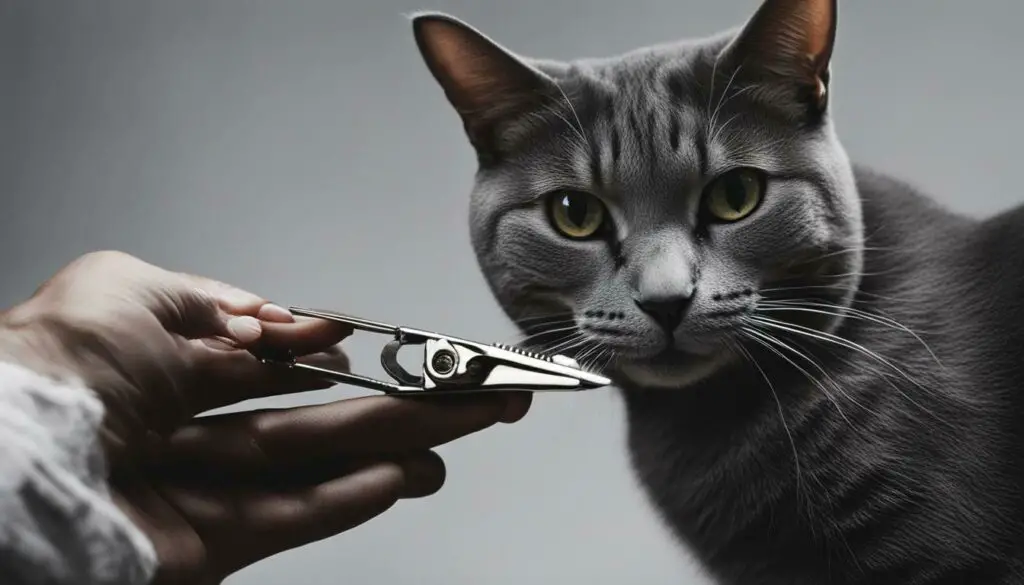
While longer claws may not be aesthetically pleasing, they can provide some benefits. They serve as a natural defense mechanism, allowing your cat to protect themselves when necessary. Additionally, longer claws provide traction and stability, especially for outdoor cats or those who enjoy climbing. However, it’s important to regularly check your cat’s claws and monitor for any signs of overgrowth or potential issues.
| Signs of Overgrown Claws | Actions to Take |
|---|---|
| Clicking sound when walking | Schedule a nail trim |
| Difficulty retracting claws | Consult a veterinarian |
| Injury or damage caused by scratching | Trim claws and redirect scratching behavior |
By prioritizing safety and following the recommended guidelines for cat nail trimming, you can maintain your feline friend’s health and prevent any unnecessary discomfort or pain. Remember to establish a regular trimming schedule, create a positive association with the clippers, and approach the process with patience and calmness. If you’re unsure or uncomfortable with trimming your cat’s nails, don’t hesitate to seek professional assistance from a veterinarian or a professional groomer. Together, we can ensure our furry friends have happy and healthy paws.
Establishing a Regular Trimming Schedule
To ensure your cat’s paws remain healthy and their nails stay at an optimal length, it’s crucial to establish a regular trimming schedule. Trimming your cat’s nails every two to three weeks is generally recommended to prevent overgrowth and maintain their overall well-being.
When it comes to choosing the right tools for the job, there are several options available. Scissors, clippers, and guillotine-style clippers are commonly used for cat nail trimming. No matter which tool you choose, it’s important to use sharp blades to ensure a clean cut and minimize any discomfort for your feline friend.
To make the nail trimming process easier and less stressful for both you and your cat, creating a positive association with the clippers can be beneficial. Offer treats whenever the clippers are present, allowing your cat to associate them with something positive. This can help reduce their anxiety and make the experience more pleasant for everyone involved.
| Key Points: |
|---|
| Trim your cat’s nails every two to three weeks. |
| Choose the right tools, such as scissors, clippers, or guillotine-style clippers. |
| Use sharp blades to ensure a clean cut. |
| Create a positive association with the clippers by offering treats. |
Remember, patience and a calm demeanor are key when it comes to trimming your cat’s nails. Avoid rushing the process or reprimanding your cat, as this can cause stress and make the experience negative. Instead, try gently rubbing your cat’s paws and rewarding them with treats to help them get comfortable with having their paws handled.
Seeking Help if Needed
If you’re unsure or uncomfortable with trimming your cat’s nails, don’t hesitate to seek professional help. Veterinarians and professional groomers are experienced in handling cat nail care and can provide assistance. They can offer guidance on the best techniques, recommend specific tools, and even demonstrate the trimming process.
By establishing a regular trimming schedule, using the right tools, creating a positive association, and approaching the process with patience and calmness, you can ensure your cat’s nails stay at a healthy length and prevent any potential issues. Taking care of your cat’s paws is an essential part of their overall grooming routine and contributes to their overall well-being.

Seeking Help if Needed
If you are unsure or uncomfortable with trimming your cat’s nails, don’t hesitate to seek professional help from a veterinarian or a professional groomer. They have the necessary experience and expertise to ensure that your cat’s nails are trimmed safely and effectively. Trimming a cat’s nails can be challenging, especially if your cat is particularly resistant or anxious. In these situations, it is best to leave it to the professionals who can handle the task with care.
Professional groomers and veterinarians have the necessary tools and knowledge to trim your cat’s nails without causing them any pain or distress. They can also provide guidance on how often your cat’s nails should be trimmed based on their individual needs. Additionally, they can offer advice on how to properly handle and restrain your cat during the nail trimming process to minimize any potential risks or accidents.
Remember, the well-being and comfort of your cat should always be the top priority. Seeking professional help ensures that your cat’s nails are trimmed safely, reducing the risk of injury to both you and your feline friend. So, if you are unsure or uncomfortable with trimming your cat’s nails, reach out to a professional who can provide the necessary assistance and guidance.
Patience and Calmness in Nail Trimming
Maintaining a calm and patient approach during nail trimming is essential for both you and your cat’s well-being. Cats are sensitive creatures, and any signs of anxiety or impatience from their owner can escalate their stress levels during the grooming process. To ensure a positive experience, follow these tips:
- Choose the right time: Pick a moment when your cat is relaxed and calm, such as after a nap or a meal. Avoid attempting to trim their nails when they are already agitated or playful.
- Create a soothing environment: Find a quiet and comfortable space where you can both relax. Dim the lights, play some soft music, and use a non-slip surface for stability.
- Take it slow: Start by gently massaging your cat’s paws to get them used to the sensation. Offer treats and praise to reinforce positive associations with paw handling.
- Use gentle restraint: Ensure your cat is securely but gently held during the nail trimming process. Avoid restraining them too tightly, as it can cause discomfort and anxiety.
- Keep it short and sweet: Begin by trimming just a few nails at a time, gradually increasing the number with each session. This helps to prevent overwhelming your cat and keeps the process manageable.
Remember, patience is key. If your cat becomes too stressed or agitated, it’s okay to stop and try again later. Consistency and positive reinforcement will help your cat become more comfortable with nail trimming over time.
By maintaining a calm and patient demeanor, you can create a stress-free nail trimming experience for both you and your cat.
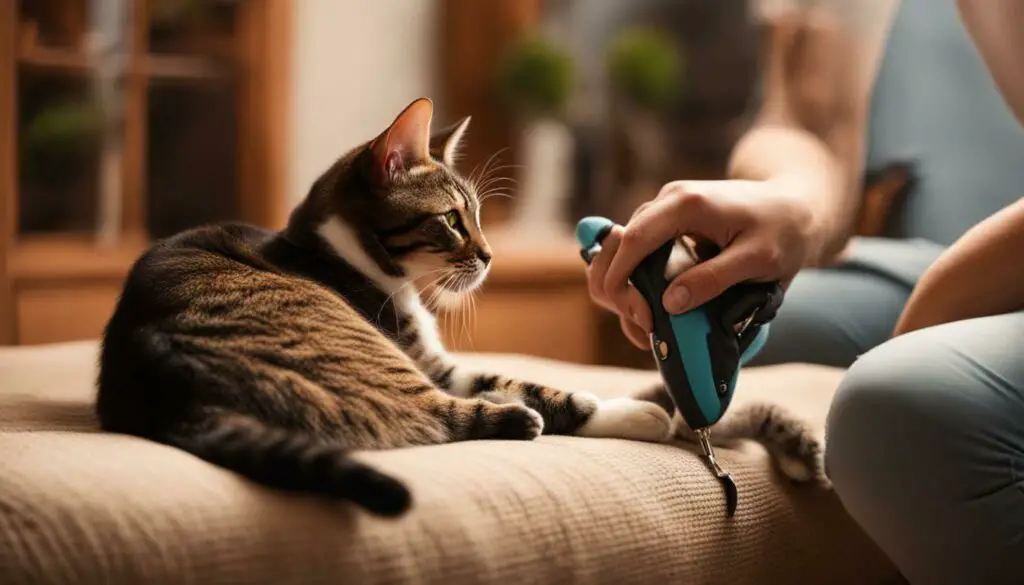
| Benefits of a Calm Approach | Why It’s Important |
|---|---|
| Reduces anxiety | A calm approach helps to alleviate stress and anxiety in your cat, making the experience more pleasant for both of you. |
| Enhances trust | By remaining patient and calm, you build trust with your cat, making future nail trimming sessions easier. |
| Prevents accidents | Cats are more likely to squirm or make sudden movements when they sense their owner’s impatience, increasing the risk of accidental injury. |
Remember, positive reinforcement and a soothing environment go a long way in creating a stress-free nail trimming routine. With practice and patience, you can ensure that your cat’s nails are well-maintained while strengthening the bond between you.
Congratulations on completing this practical guide on how often to clip your cat’s nails.
By following these tips and guidelines, you can ensure your feline friend’s paws remain healthy and safe.
Regular nail trimming is important for maintaining your cat’s health and preventing damage to furniture. It is recommended to trim a cat’s claws every two to three weeks to keep them at a manageable length. There are various tools available for trimming, such as scissors, clippers, or guillotine-style clippers. It is important to use sharp blades to avoid causing pain or bleeding.
To make the process easier, it is suggested to create a positive association with the clippers by offering treats whenever they are present. Additionally, getting your cat comfortable with having their paws touched can help reduce anxiety during nail trimming. Gently rub their paws and reward them with treats to create a positive association.
When it comes to trimming, it is important to only trim the sharp tip of the nail and avoid cutting into the quick, which is the pink part of the nail where nerve endings and blood vessels are located. It is better to have longer claws than to risk cutting too deep. Establishing a regular trimming schedule and seeking help if needed are also important factors to consider.
Remember to approach the nail trimming process with patience and a calm demeanor. Avoid reprimanding the cat or rushing the process, as it can cause stress and anxiety. By following these guidelines, you can successfully trim your cat’s nails and maintain their overall well-being.
FAQ
How often should I clip my cat’s nails?
It is recommended to trim your cat’s claws every two to three weeks to maintain their health and prevent damage to furniture.
What tools should I use for cat nail trimming?
You can use scissors, clippers, or guillotine-style clippers. Just make sure to use sharp blades to avoid causing pain or bleeding.
How can I make the nail clipping process easier for my cat?
You can create a positive association with the clippers by offering treats whenever they are present. Additionally, getting your cat comfortable with having their paws touched by gently rubbing their paws and rewarding them with treats can help.
How should I trim my cat’s nails?
It is important to only trim the sharp tip of the nail and avoid cutting into the quick, which is the pink part of the nail where nerve endings and blood vessels are located. It is better to have longer claws than to risk cutting too deep.
What should I do if I am unsure or uncomfortable with trimming my cat’s nails?
If you need assistance, it is recommended to seek help from a veterinarian or a professional groomer who can guide you through the process.
How should I approach the nail trimming process with my cat?
It is important to approach the process with patience and a calm demeanor. Avoid reprimanding the cat or rushing the process, as it can cause stress and anxiety.

